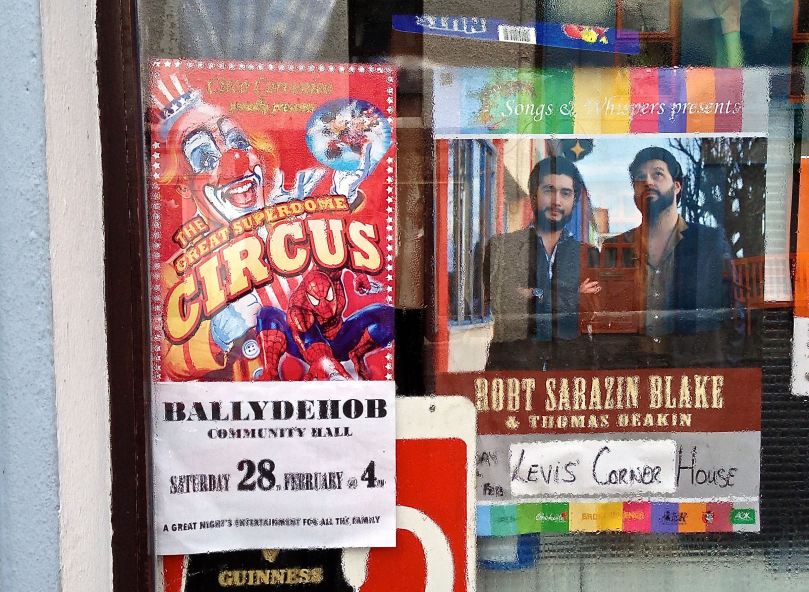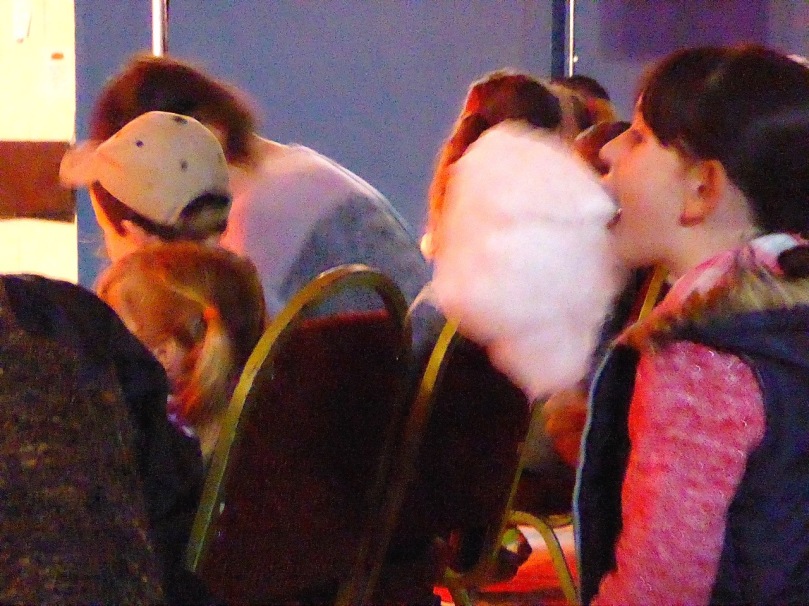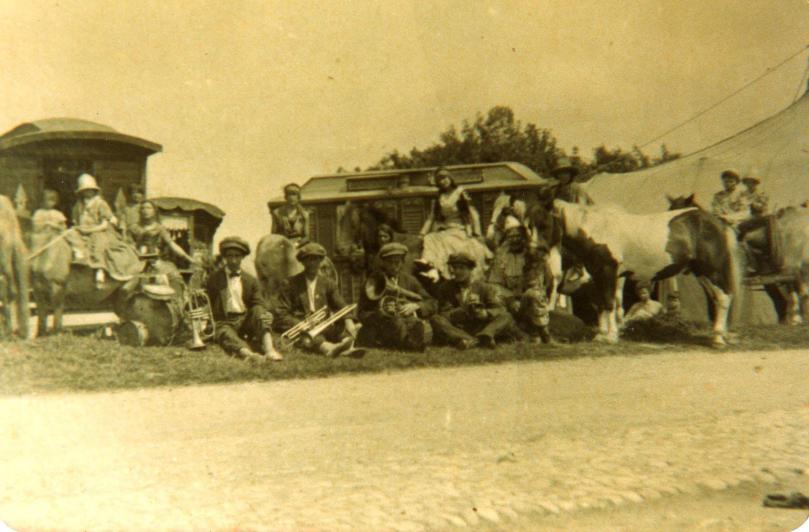
In my post From Skibbereen to the Moon I wrote about the Clerke family of Skibbereen, but particularly about Agnes, who became one of the foremost astronomers and science writers of her day. But Agnes was one of a trio of remarkable siblings, each of who distinguished themselves as intellects and writers and I wanted to learn more about her sister, Ellen, and her brother, Aubrey. In the process, I came up with questions that reach into the heart of Skibbereen, and Irish, history.

Bridge Street, Skibbereen
But first – the Clerke (pronounced Clark) family: all three siblings grew up in Skibbereen, above the bank that their father managed. They lived through the Famine: John Clerke was one of the subscribers to the soup kitchen relief effort. After moving away in 1861, and apart from the years the women spent in Italy, the family lived together for the rest of their lives.

Used as a soup kitchen during the Famine

Above the bank – their home and school
It was, by all accounts, an harmonious and supportive household. The three were devoted to their parents and they encouraged and nurtured each other’s scientific and literary pursuits. Aubrey coached Agnes in mathematics when she needed to move to a higher level of understanding in her astronomy studies, and the siblings accompanied each other to the various astronomical and geographical societies that each belonged to. Ellen was the stronger of the two sisters (Agnes’s health was poor from childhood) and also the more social. According to Lady Huggins account, she played the guitar and sang well, she liked to ride and she “pulled a good oar.”

While Agnes wrote mainly (although not exclusively) about astronomy, Ellen was more literary in her leanings, publishing extensively in the areas of poetry and criticism and writing in three (at least) languages. The book for which she should be most justly remembered is Fable and Song in Italy. Ellen’s objectives with this book were twofold: to trace the influences on popular Italian song and to to introduce English readers to Italian verse. In order to do this she must have possessed an encyclopaedic knowledge of the great Italian poets and the ability to translate Italian verse to English verse. This had to be an incredibly difficult undertaking, not least because she was translating archaic Italian into a more contemporary language (that is, of her own time) in order that the “beauties” of the verse would not be “disguised by the obsoleteness of the language.” She begins in the Renaissance with the Fifteenth Century Boiardo, author of Orlando Innamorato, a classic of European chivalric literature. Her account of the piece Charlemagne’s Tournament from Orlando is complete with the story itself, discursive asides about the numerous characters and translations of selected verses.

From Fable and Song in Italy, Ellen’s best work
She moves on to Boccacio, author of the Decameron. Crediting him with “giving the metrical romance an established place in literature” she asserts that he “supplied the poetry of the future with its main outlet of expression…” She provides many pieces of translation and compares his verbose style to Chaucer’s (an admirer of Boccacio) more succinct phrasings, tracing the influences of the Italian on the English poet with great skill and using numerous illustrations. She has a chapter on The Hercules Saga and on the verse letters of the poet Ariosto; she describes the potent roles played by Dante and Petrarch in Italian verse; she works her way through a chapter on Italian Folk Songs to finish with a discourse on Manzoni and Modern Romanticism. It’s a tour de force, showing a strong intellect operating at the height of its powers. But it’s also fascinating in that, as a devout Catholic with a Victoria sensibility, she deals with the sometimes hot and overblown romantic verse in a calm and often wryly humorous way, noting for example that despite all the chivalry and elevation of romantic love, Ariosto’s real estimation of women was evidently “very low,” as he “alternates between raillery and panegyric.”

Everyone who was anyone wrote for the Famous Cornhill Magazine
Ellen wrote for various magazines, especially The Tablet (a Catholic periodical which she also helped to edit), the Cornhill Magazine and the Dublin Review (another influential Catholic journal, actually published in London). Although she never reached the stature of Agnes in astronomy, she was likewise interested in that subject and wrote two monographs on Jupiter and on Venus. A review of Jupiter and his Systems calls it a “capital little pamphlet” (it was 40 pages) and says it presents “a complete popular account of our present information regarding this planet and its satellites…in an interesting and straightforward way, equally removed from dullness and from the faintest traces of “smart writing.”” She wrote literary studies in German and she studied Arabic to the extent of using original Arabic texts in her research. She was a highly regarded member of the Manchester Geographical Society (which admitted women!). One of her pieces for them was about Australian aborigines which was described as a “striking refutation of the generally held belief about them”. Another one of her journalistic essays was about the dock labourers strike of 1889 in which she displayed her understanding of economics, her insistence on factual information (she used extensive statistics) and her empathy for low paid workers and their families, although in general her politics were conservative.

Cover, Aubrey Beardsley. Poem, Ellen Clerke
Ellen’s venture into fiction was not, alas, as well received as her journalism and science writing. Just before she died she published her only novel, Flowers of Fire. I have found a single review, which pans it. “This story is interesting,” it states, “as proving that neither Polish conspiracies nor Neapolitan courtships can fill the dreary void left in a novel by the absence of men and women…[The characters] are distinguished from each other only by some external badge, such as yellow hair or a hot temper, and by the single hard black line that marks off the good characters from the bad.”
I couldn’t find the text of Ellen’s novel online, but I did come across a poem she translated from French, with the same title. It was published in The Yellow Book – a very smart quarterly with cover designs by Aubrey Beardsley. I have appended the poem to the bottom of this post.
Aubrey St John Clerke, like his sisters, was brilliant. He won gold medals at Trinity in Mathematics and in Science and was awarded a “studentship” of £100 per year – “the highest honour obtainable at the Degree examination.” Although trained as a scientist, he chose to make his career in law, in which profession he became a specialist in land and property law and wrote books on the land law and conveyancing and articles for magazines, such as one for the Dublin Review of 1880 on ‘The Land Question and Law Reform.’
These books and articles on buying and selling land were more than simple treatises on conveyancing: they were a significant contribution to Irish and British law, since a series of Land Acts, beginning in 1870 were passed, designed to transfer the ownership of property from the large landowners to the Irish people who lived and worked on it. Each Act improved on the one before, but all were complex and there were no precedents to depend on. But Aubrey did not confine himself to law and wrote on other topics too. At one point, in 1878, all three Clerke siblings were in print. According to Mary Brück’s biography of Agnes, Aubrey’s contribution was a piece in the Quarterly Review “on a political question in which he showed himself a staunch Unionist and Anglophile.”

Clerke plaque, Bridge Street

The other Bridge Street Plaque: O’Donovan Rossa
It’s interesting to note, in this regard, that when the Clerkes lived in Skibbereen, in the Bank House on Bridge Street, O’Donovan Rossa, the Fenian leader, was running a business further up the same street. Did John Clerke, in his capacity as the Bank Manager, have dealings with Rossa (who ran into financial difficulties with his seed business)? How did the conservative Clerkes feel about the Phoenix National and Literary Society that Rossa founded with the aim of liberating Ireland ‘by force of arms.’ How usual or unusual was it for staunch Catholics, such as the Clerke siblings, to be committed unionists and anglophiles? How would Aubrey feel, do you think, if he knew that the other memorial plaque on Bridge Street is to honour the memory of a Fenian?

Redcliffe Square, home to the Clerkes in London
Agnes and Ellen died within months of each other. Aubrey was the youngest of the family and the last to survive, living on alone in the grand house in London, becoming in the end reclusive. I can find no photograph of him or of his father: in this family it is the women who are most remembered. To his credit, Aubrey never seemed to resent that, remaining proud of and devoted to his two extraordinary sisters always.
Flowers of Fire
A Translation, by Ellen M. Clerke
FOR ages since the age of Chaos passed,
Flame shot in torrents from this crater pyre,
And the red plume of the volcano’s ire
Higher than Chimborazo’s crown was cast.
No sound awakes the summit, voiceless, vast,
The bird now sips where rained the ashes dire,
The soil is moveless, and Earth’s blood on fire,
The lava—hardening—gives it peace at last.
But, crowning effort of the fires of old,
Close by the gaping jaws, for ever cold,
Gleaming ‘mid rocks that crumble in the gloom,
As with a thunderclap in hush profound,
‘Mid golden dust of pollen hurled around,
The burning cactus blazes into bloom.
Email link is under 'more' button.








































































